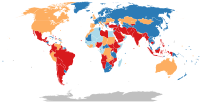
Photo from wikipedia
Abstract Introduction The aims of this survey were to assess the experiences of the transition from in-person to virtual meetings among European pediatric surgeons since the beginning of the coronavirus… Click to show full abstract
Abstract Introduction The aims of this survey were to assess the experiences of the transition from in-person to virtual meetings among European pediatric surgeons since the beginning of the coronavirus disease 2019 (COVID-19) pandemic and to identify preferences for future formats. Materials and Methods An online questionnaire was circulated among members of the European Reference Network for rare Inherited and Congenital Anomalies Network (ERNICA) in 2022. Two time periods were compared (3 years before the COVID-19 pandemic vs. the year 2021). Results A total of 87 pediatric surgeons from 16 countries completed the survey. In addition, 27% of respondents were trainees/residents and 73% consultants/lead surgeons. Consultants participated in significantly more in-person congresses prior to the COVID-19 pandemic compared with trainees (5.2 vs. 1.9; p < 0.001). A significant increase in attendance of virtual meeting was reported during 2021 compared with pre-COVID-19 (1.4 vs. 6.7; p < 0.001). Consultants had experienced significantly less absenteeism thanks to virtual meetings compared with trainees (42/61 vs. 8/23; p < 0.05). Most surgeons considered virtual meetings more economic (82%), practical (78%), and family-friendly (66%). However, a majority reported missing social events (78%). The communication among attendees or between attendees and speakers or scientific faculty was deemed worse. A minority (14%) experienced equalized representation of trainees and consultants at virtual meetings. Most respondents (58%) agreed that future meeting strategies should focus on offering virtual formats. Regarding future congresses, respondents prefer hybrid (62%) over in-person (33%) or virtual (6%) formats. Conclusion According to European pediatric surgeons, virtual learning formats hold multiple advantages and should be continued. Improved technology must meet the challenges, particularly to enhance communication, equal representation, and networking between attendees.
Journal Title: European Journal of Pediatric Surgery
Year Published: 2023
Link to full text (if available)
Share on Social Media: Sign Up to like & get
recommendations!